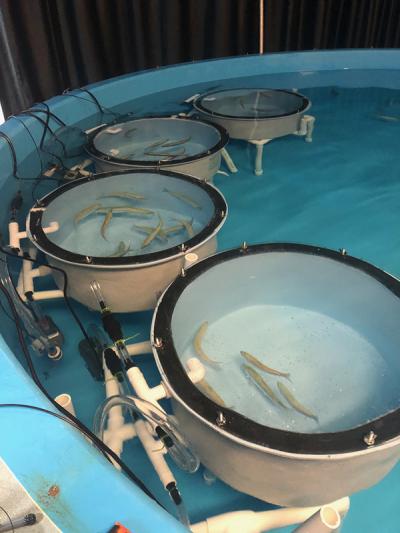As climate change causes ocean temperatures to warm, scientists worry the size of California’s Pacific sardines—immortalized by Monterey’s Cannery Row—may be getting smaller. It takes more energy for fish to survive in warmer waters, which could limit the growth of one of the state’s most important fish.
Sardines are crucial to the food web off the coast of California. Lisa Komoroske of the University of Massachusetts Amherst describes them as a “forage fish”—a primary source of food for economically important fish, such as the endangered California coho and threatened Chinook salmon.
Previous studies have found other fish species have smaller body sizes due to warming as well. To find out if the same pattern exists among sardines and understand the physiology behind it, Komoroske is leading a team of researchers with partners at NOAA and UC Davis to study the shimmering silver fish as part of the Healthy Coastal Ecosystems project funded by California Ocean Protection Council’s Proposition 84 Competitive Grant Program, which is administered by California Sea Grant and the University of Southern California Sea Grant.

“We're just getting to the phase of the project where we can figure out how much energy they need to survive and grow,” Komoroske says. “And if they’re smaller at higher temperatures, we’ll be able to put the pieces together to understand how greater energetic demand relates to their growth and other physiological processes.”
With warming temperatures, the sardines’ function in the ecosystem may change. Smaller fish often lay fewer eggs, which ultimately could reduce the population and mean less fish food for larger fish and other marine animals that rely on them.
To understand the future of the fish, Komoroske and her team, led by postdoctoral scholar Joshua Lonthair, collected over 2,000 Pacific sardines. They studied the oxygen limits and metabolic demand of the fish at a series of temperatures in experiments called respirometry trials, essentially a fitness test, and looked at how much oxygen the fish consumed.
“We're able to see what the highest temperatures and lowest oxygen that they can survive at (are), and then how much energy they need to grow and persist under these conditions.”
The scientists followed a standardized protocol to measure oxygen consumption of the Pacific sardine, which involved placing the fish in a sealed chamber with probes connected to a computer to collect dissolved oxygen measurements every second. In particular, the team focused on two metrics to estimate how much energy the sardines need: routine metabolic rate and maximum metabolic rate. The first, Komoroske says, is like us sitting at home at our desk, not doing much other than breathing.
“But then a maximal metabolic rate would be if you went out and did a sprint, or something else that required the most energy you can use in a given time.”
For this, the scientists followed what’s known as a standard chase protocol and chased each fish by hand for five minutes before placing it into a sealed container to measure how much oxygen the fish consumed after exercise.
With increasing water temperatures, the fish were less tolerant to low oxygen levels and their routine metabolic rate increased. This means the fish are using more energy just to survive in warmer conditions, which could mean there is less energy for important processes like growth, reproduction and foraging.
Though affected by warmer temperatures, the preliminary results suggest sardines are resilient to low oxygen during short-term exposure, which indicates some resilience to decreasing ocean oxygen levels that are consistent with climate change.
Komoroske and her team are now doing the same study with brook trout. The fast-growing trout will provide another dataset to compare to the sardines and more broadly understand the physiological links between reduced growth and warming temperatures. The team is currently analyzing the final results of both studies.
Next up, the team would like to study whether slow-growing fish are also exhibiting decreased growth in warming oceans, as well as find out how different species of fish react in ecosystems with variable temperatures.
About California Sea Grant
NOAA’s California Sea Grant College Program funds marine research, education and outreach throughout California. Headquartered at Scripps Institution of Oceanography at the University of California San Diego, California Sea Grant is one of 34 Sea Grant programs in the National Oceanic and Atmospheric Administration (NOAA), U.S. Department of Commerce.